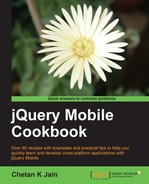- jQuery Mobile Cookbook
- Table of Contents
- jQuery Mobile Cookbook
- Credits
- About the Author
- Acknowledgement
- About the Reviewers
- www.PacktPub.com
- Preface
- 1. Get Rolling
- 2. Pages and Dialogs
- Introduction
- Writing a single-page template application
- Writing a multi-page template application
- Prefetching pages for faster navigation
- Using the DOM cache to improve performance
- Custom styling a dialog
- Using CSS to create a bouncing page transition
- Using JS to create a slide and fade page transition
- Using data-url to handle the login page navigation
- Using History API to create a custom error pop up
- 3. Toolbars
- 4. Buttons and Content Formatting
- 5. Forms
- Introduction
- Native styling of form controls
- Disabling text controls
- Grouping radio buttons in a grid
- Customizing a checkbox group
- Creating dynamic flip switch and slider controls
- Using options to auto-initialize a select menu
- Validating forms
- Submitting a form using POST
- Fetching data using GET
- Creating an accessible form
- 6. List Views
- 7. Configurations
- Introduction
- Configuring the active classes
- Configuring ajaxEnabled
- Configuring autoInitializePage
- Configuring the default transitions
- Configuring ignoreContentEnabled
- Configuring the page loading and error messages
- Configuring the default namespace
- Configuring hashListeningEnabled and subPageUrlKey
- Configuring pushStateEnabled and linkBindingEnabled
- 8. Events
- 9. Methods and Utilities
- 10. The Theme Framework
- 11. HTML5 and jQuery Mobile
- Introduction
- Using the new HTML5 semantics
- Improving speed and taking your application offline
- Using Web Workers for intensive tasks
- Using local and session storage
- 2D drawing with Canvas
- Applying Gaussian blur on a SVG image
- Tracking your location with the Geolocation API
- Playing music with the <audio> element
- Viewing videos with the <video> element
- Index
In this book, you will find a number of styles of text that distinguish between different kinds of information. Here are some examples of these styles, and an explanation of their meaning.
Code words in text are shown as follows: "Now, open the main.html file in your favorite browser, and you will see an output similar to the following screenshot:".
A block of code is set as follows:
<body>
<!-- Main Page -->
<div id="main" data-role="page">
<div data-role="header">
<h1>Welcome - JS BIN</h1>
</div>
<div id="content" data-role="content">
<p>The jQuery Mobile Cookbook</p>
</div>
<div data-role="footer">
<h4>Enjoy reading the book ...</h4>
</div>
</div>
</body>
</html>When we wish to draw your attention to a particular part of a code block, the relevant lines or items are set in bold:
<!DOCTYPE html> <html> <head> <link href="http://code.jquery.com/mobile/latest /jquery.mobile.css" rel="stylesheet" type="text/css" /> <script src="http://code.jquery.com /jquery-1.7.1.min.js"></script> <script src="http://code.jquery.com/mobile/latest /jquery.mobile.js"></script> <meta name="viewport" content="width=device-width, initial-scale=1"> <title>Welcome using JS Bin</title> </head>
New terms and important words are shown in bold. Words that you see on the screen, in menus or dialog boxes for example, appear in the text like this: "You can also manually run the script by clicking on the Run with JS button."
-
No Comment
..................Content has been hidden....................
You can't read the all page of ebook, please click here login for view all page.
